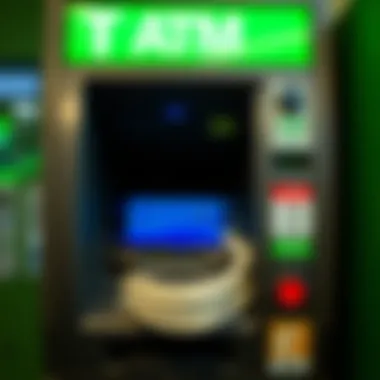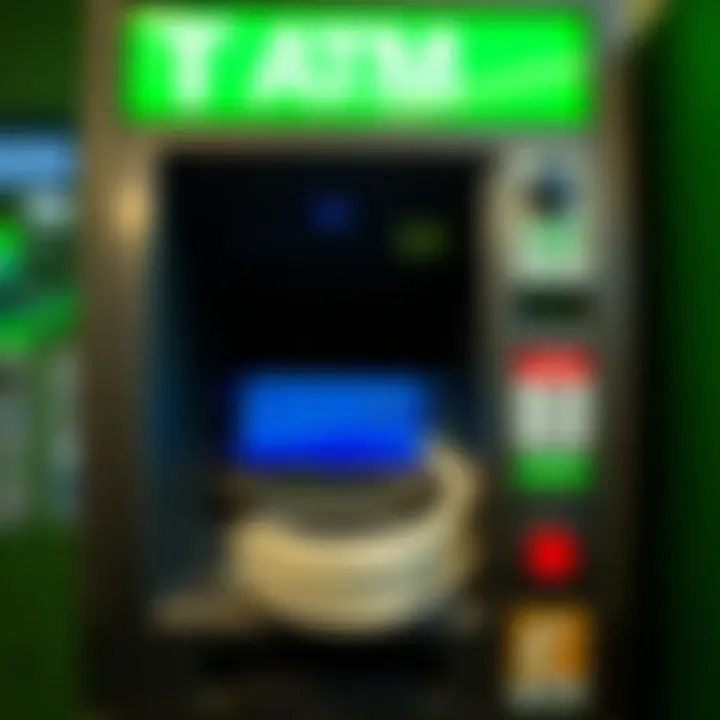TD Bank ATM Withdrawal Limits Explained


Intro
Managing your finances often requires navigating through a maze of policies, especially when it comes to banking institutions. In the case of TD Bank, understanding ATM withdrawal limits is crucial for customers who want to maximize their access to cash while minimizing unnecessary fees or issues. As you explore this topic, you will discover how various elements influence these limits, and uncover the strategies available to enhance your banking experience.
Whether you're a novice in personal finance or have been around the block a few times, this guide offers insights into not just the limits themselves but also the positional dynamics they bring to your financial planning. The goal is to demystify how TD Bank sets its withdrawal limits, what influences them, and how you can navigate these limits effectively.
As differing factors come into play—such as the type of account you hold, your transaction history, and even your overall banking habits—getting a grasp of these limitations can be the key to avoiding any frustrating cash access mishaps. We’ll dive into daily and transaction limits, explore insights offered by experts in the field, and even look at how to adjust your withdrawal capabilities if needed.
Preamble to TD Bank ATM Withdrawal Limits
Navigating the world of banking can feel like sailing through uncharted waters, especially when it comes to understanding ATM withdrawal limits. These limits are the amount of cash you can withdraw from ATMs, and they play a significant role in managing your funds. For TD Bank customers, grasping these limits can make or break your financial flow.
ATM withdrawal limits are crucial for several reasons. For starters, they can influence your budgeting and spending habits. Getting a clear picture of how much you can take out and when helps you avoid overdraft fees and potential cash shortages.
Why should you care about understanding these limits? For one, they’re not set in stone. If you're a savvy customer, you might find opportunities to increase those limits to better suit your financial needs. Moreover, with the rise of digital banking, knowing your cash flow can keep you alert to any changes that could affect your overall financial health.
In this section, we will explore the specifics of what ATM withdrawal limits actually are, and why they matter.
What Are ATM Withdrawal Limits?
At their core, ATM withdrawal limits refer to the maximum amount of money a customer can withdraw from an ATM within a specified period, typically a 24-hour window. This limit can vary from one bank to another and even among customers of the same bank. For instance, TD Bank might offer different limits based on the type of account you hold—be it a regular checking account or a higher-tier account like a premium savings plan.
Understanding these limits is crucial because they govern how much cash you can access quickly. Moreover, ATM limits can be affected by factors like your banking relationship, account age, or any security measures your bank has in place to protect against fraud.
Importance of Understanding Limits
When it comes to managing your finances efficiently, knowing your ATM withdrawal limits is vital.
- Plan Ahead: Understanding your limits allows you to plan for larger purchases or unexpected expenses. If you know your limit is $300 per day, you can strategize your withdrawals accordingly.
- Avoid Surprises: Sudden changes in limits due to account issues can throw a wrench in your plans. Being aware of your limits helps you stay ahead.
- Financial Emergencies: Emergencies don’t happen on our schedule. When you’re in a pinch, knowing your cash access can make the difference between stress and smooth sailing.
In essence, ATM withdrawal limits are more than just numbers; they define how you interact with your money on a daily basis. If you keep your eyes peeled and stay informed, you'll be able to maneuver through these limits with ease, maximizing your overall banking experience.
Daily Withdrawal Limits
Understanding daily withdrawal limits is crucial for anyone managing their finances at TD Bank. These limits determine how much cash you can withdraw from ATMs in a single day, impacting not just your day-to-day spending but also your financial planning in larger terms. For the average user, knowing these limits can prevent embarrassing situations like being unable to access cash when needed.
Daily withdrawal limits are essentially there for your protection, helping to mitigate risks associated with fraud and unauthorized access to your account. Excessive withdrawals can raise red flags, and limits serve to safeguard both the bank and its customers. Moreover, they pave a clear path for budgeting considerations.
For instance, knowing that you can only withdraw a specific amount a day might help you manage your cash flow better, preventing reckless spending. Understanding these daily limitations can also guide you in planning for larger purchases, ensuring you don't run into financial hurdles at inopportune moments.
Standard Daily Limits for TD Bank Customers
When it comes to TD Bank, the standard daily withdrawal limit for most customers typically sits at approximately $500. This common cap reflects a balance between giving customers access to their funds and safeguarding against misuse. However, it's essential to clarify that not all accounts are created equal.
Different account types, such as basic checking, premium checking, and even certain savings accounts, may feature distinct limits. For example, someone with a TD Convenience Checking account might find their limit set at that standard $500, while a premium account might offer higher withdrawal allowances.
The limits do not merely cater to individual account types but also to the bank’s stipulations which can vary based on various factors, such as account tenure and customer relationship history. If you find yourself regularly reaching that limit, it might be worthwhile to explore options with the bank that provide enhanced access to funds.
Factors Influencing Daily Limits
Several elements come into play when determining daily withdrawal limits at TD Bank. Here are the key factors:
- Account Type: As mentioned earlier, the nature of your account can significantly influence your withdrawal capability. Accounts designed for higher balances tend to offer better limits.
- Customer Relationship: Loyalty often pays off. Long-term customers with consistent banking history might enjoy increased limits as a reward for their continued business.
- Recent Transactions: If you've made frequent withdrawals recently, the system might flag your account for security. This behavior can temporarily affect your daily limits.
- Fraud and Security Controls: TD Bank practices vigilance regarding unusual account activities. Any flagged transactions could unintentionally impact your daily withdrawal limit.
Ultimately, being aware of these daily limits and the influences behind them empowers you to harness your banking relationship better. It can guide decisions about savings plans, spending behavior, and overall financial strategy—always keeping one step ahead in your financial endeavors.
Transaction Limits
Understanding transaction limits is crucial for TD Bank customers, as these limitations directly impact how much cash you can withdraw during a specified period. In the bustling world of personal finance, knowing these constraints can help prevent any unwanted surprises when attempting to access funds for everyday needs or emergencies. Transaction limits serve as both a safeguard and an inconvenience, balancing the convenience of ATM access with the bank's fraud prevention policies.


Withdrawal limits include two primary components: single transaction limits and cumulative daily limits. Each has its implications on how customers can withdraw cash, manage their finances, and respond to immediate needs.
Single Transaction Limits
Single transaction limits refer to the maximum amount of money you can take out in one go from a TD Bank ATM. As of now, this cap is generally set at $500, which is a fairly standard figure among various financial institutions. However, these figures can fluctuate based on account type and individual banking circumstances.
Consider a scenario where you have to pay a large bill needing immediate cash—understanding that you’re capped at that $500 limit will help you make contingency plans when you need more. Ask yourself, can you break the payment into smaller amounts? Can you time your withdrawals appropriately to adhere to this restriction? Instead of running into trouble on a Friday evening, plan your expenses early in the week when the bank's services are sturdy and accessible.
Cumulative Daily Limits
Cumulative daily limits take the concept of withdrawal caps a step further. This encompasses the total amount of cash you can withdraw within a 24-hour period, usually standing at about $1,000 for most TD Bank customers. This restriction combines all your ATM transactions, providing a daily threshold to manage your banking activities and mitigate risks associated with fraud.
For instance, if your daily cap is $1,000 and you withdraw $300 in the morning, you’ll only be able to take out an additional $700 for the rest of the day. If your plans change—or an unexpected emergency arises—you might find yourself stuck if you hit that limit too soon. Here, foresight is vital. It might help to know your usual spending habits and perhaps even set aside some cash during the week so you won’t feel strapped when the need arises.
"Knowing your withdrawal limits ahead of time isn’t just a good practice—it’s a financial lifesaver."
Factors Affecting Withdrawal Caps
Understanding the factors that affect withdrawal caps at TD Bank is crucial for customers. It can help you make informed decisions, plan your finances better, and avoid unnecessary inconveniences. Generally, withdrawal limits aren't set in stone; they can fluctuate based on several aspects, which can impact your banking experience significantly.
Account Type and Status
The type of account you hold at TD Bank plays a pivotal role in determining your ATM withdrawal limits. For instance, if you're a holder of a basic checking account, your limits may be lower than those associated with premium accounts. With a premium account, like a TD Bank Relationship Checking account, you often enjoy higher limits and additional perks.
Moreover, account status can also influence your withdrawal capabilities. If your account is in good standing, your limits will typically be more favorable. On the flip side, any flags on your account, like overdrafts or missed payments, could lead to lower withdrawal limits.
Consider the following factors related to account type and status:
- Basic Checking Accounts: These tend to have lower limits. They’re a good option for those who rarely withdraw cash.
- Premium Accounts: Higher limits suited for customers who engage in regular ATM transactions or need access to more cash.
- Account Issues: Flags due to overdrafts or inactivity can result in diminished withdrawal capabilities.
Banking Relationship History
Another essential element that dictates ATM withdrawal limits is your banking relationship history. How long have you been a customer? Have you maintained a positive banking history? These questions matter because banks take into account your overall relationship when setting limits.
If you've been banking with TD for years and have a solid record, you may find your limits adjusted favorably. Conversely, if you’re a relatively new customer with minimal banking activity, the limits might not be as generous.
To illustrate how banking history influences limits:
- Long-Term Customers: Usually see friendlier limits reflecting loyalty and trustworthiness.
- New Customers: Might experience restrictions as the bank assesses stability and relationship quality.
- Positive Activity: Consistent deposits and responsible account management often lead to higher limits.
A relationship marked by trust and responsible banking habits generally eases the path to higher withdrawal limits. By being aware of these factors, you can navigate your banking experience more effectively and avoid the pitfalls of unapproachable ATM withdrawal limits.
"Understanding these factors can empower you to tailor your banking habits to meet your needs, pushing the boundaries of how much cash you can access at a time."
By managing your account type wisely and fostering a healthy banking relationship, you stand to benefit greatly when it comes to ATM withdrawal limits. But remember, the precise dynamics can vary, so it’s always wise to check with TD Bank for the most accurate information regarding your specific circumstances.
Increasing Your ATM Withdrawal Limit
Increasing your ATM withdrawal limit can have significant implications for your financial flexibility. It allows you greater access to your funds when you need them most, like during emergencies or when making larger purchases. However, it’s not just about having more cash available. Understanding this process, including how to request an increase and the importance of maintaining good banking practices, can shape a better relationship with your bank. Being proactive can also prevent you from facing uncomfortable situations where funds are locked due to low withdrawal limits.
Requesting a Limit Increase
When you find that your current cash withdrawal limits are just too tight for your lifestyle, the first step is to request a limit increase. For this, it’s usually just a quick call or visit to your TD Bank branch. You might think it’s more complicated than it is. Typically, you’ll need to provide some personal details and explain why you need an increase. Here are some factors to consider:
- Account Standing: Ensure your account is in good standing. If your banking habits have been smooth, like making regular deposits and avoiding overdrafts, you're in a favorable position.
- Clear Explanation: Be specific about why you need the increase. Whether it’s for travel, an unexpected expense, or a big purchase, giving a clear reason can help your case.
- Limit Timing: Consider timing your request with significant life changes, such as starting a new job or purchasing a home. This shows your financial reliability has potentially increased.
Most importantly, don’t shy away from following up. If the request is denied, seek feedback on what requirements need to be met for approval later on.
Maintaining Good Banking Practices


To enhance your chances of obtaining a withdrawal limit increase, it’s critical to consistently practice good banking habits. These practices not only reflect positively on you as a customer but also bolster your bank's trust in your financial stability. Here are some good habits to adopt:
- Regular Deposits: Make habitually regular deposits in your account. This shows a steady inflow of funds, indicating stability to your bank.
- Timely Payments: Whether it's credit cards, loans, or other banking products, ensure that you pay your dues promptly. Late payments could flag your account as risky.
- Monitor Your Account: Keep an eye on your account activity. Regularly checking transactions can prevent unusual activities and help maintain your financial health.
- Personal Financial Management: Using budgeting apps or maintaining a budget manual can demonstrate to the bank that you are actively managing your finances, which can support your request.
Maintaining good banking practices not only strengthens your request for a withdrawal limit increase but also sets a foundation for sound financial habits.
Impact of Withdrawal Limits on Financial Planning
Understanding the withdrawal limits set by TD Bank is critical for anyone serious about managing their finances effectively. These limits play a significant role in shaping how you handle your money, especially when unexpected expenses arise. With a clear grasp of your ATM withdrawal capabilities, you can make informed decisions and prevent potential financial distress caused by limit constraints.
Budgeting with Withdrawal Constraints
Whenit comes to budgeting, awareness of your ATM withdrawal limits from TD Bank can greatly influence your financial planning. If you know you can only access a certain amount each day, it forces you to plan your expenditures accordingly. For example, if the daily limit is set at $500, budgeting for larger purchases becomes a strategic game. You might choose to stagger your payments, withdrawing $250 one day and the remainder the next.
This strategy helps ensure you’re not left high and dry if you need cash for essentials. Additionally, understanding these limits helps avoid overdrafting your account or incurring extra fees.
Here are a few effective budgeting strategies that take withdrawal constraints into account:
- Track Your Withdrawals: Keep a close eye on what you take out and when. This will help you stay aligned with your budget and help you keep track of cash flow.
- Plan for Larger Expenses: Anticipate big-ticket costs. Instead of waiting until the last moment, withdraw and allocate funds ahead of time, spreading it out over several days if you need to.
- Set Aside Emergency Cash: If possible, set a portion of your weekly expenditure aside to ensure you always have a financial cushion, even within the constraints of withdrawal limits.
By rather proactively working within these limits, you can maintain control over your finances and avoid unexpected surprises.
Financial Emergencies and Limitations
Life is unpredictable. Whether it's an urgent car repair or a medical bill that springs up out of nowhere, having a tight grip on your ATM withdrawal limits during a financial emergency is crucial. Knowing these limits can empower you to react swiftly when situations demand.
In times of crisis, understanding what you can withdraw can mean the difference between efficiently addressing an emergency and scrambling for funds. If you're peeking at a $500 daily limit but face a $1,200 hospital bill, it's clear that withdrawals alone might not cut the mustard. Rather, you might need to look into other options, like bank transfers or discussing payment plans with service providers.
"Emergencies don’t wait for convenient withdrawal limits to relax. So knowing how much you can access can help you be prepared for the unpredictable."
So, in light of these factors, it’s imperative that you regularly assess your withdrawal capabilities. Planning for emergencies and understanding your access restrictions can help ensure that financial turbulence becomes a mere bump in the road rather than a derailment of your financial stability.
Fees Associated with ATM Withdrawals
Navigating the world of ATM withdrawals can be a minefield if one isn’t careful. Knowing about fees associated with these transactions is crucial for maintaining financial health and ensuring each dollar is utilized wisely. TD Bank, like many financial institutions, has specific fee structures in place that can impact its customers. Understanding these fees can help customers make more informed decisions when they need cash, or even when they simply want to check their account balances.
The importance of understanding ATM withdrawal fees cannot be overstated. They can quickly add up and lead to unnecessary expenses, especially for those who frequently rely on ATM transactions. Here are a few reasons why grasping the nuances of these fees is key:
- Avoidance of unnecessary costs
- Better budgeting and financial planning
- Enhancing financial literacy and making informed choices
These fees can either leave some users feeling drained or empower them to take control of their finances. Let's delve deeper into what these charges entail.
Potential Fees for Exceeding Limits
When it comes to withdrawal limits set by TD Bank, exceeding them often results in fees. If you attempt to withdraw more than your established daily limit, you might face immediate repercussions.
Some critical points to consider:
- Withdrawal Limit: TD Bank has daily withdrawal limits, which can vary based on account type and customer relationship. Exceeding these might incur penalties.
- Fee Structure: Depending on how much you exceed the limit, fees can vary. It’s worth checking if there's a flat fee or if the fee scales with the amount over the limit.
- Repeated Offenses: If you regularly exceed your limit, that may cause your bank to reevaluate your account status or impose stricter limits.
Understanding these elements helps users steer clear of unwanted fees. As an illustration, consider a scenario where a customer with a daily limit of $500 tries to withdraw $700. Not only might they incurr a fee, but they may also lose access to funds they planned to use later. Hence, it’s prudent to plan withdrawals accordingly.
Out-of-Network ATM Fees
We live in a fast-paced world where convenience often outweighs everything else. However, using out-of-network ATMs can come with its share of inconveniences, namely fees. TD Bank customers might discover that using an ATM that doesn’t belong to its network incurs charges. This is pertinent for multiple reasons:
- Understanding Costs: Out-of-network ATMs typically charge users both a convenience fee and a service fee. This means, you could see deductions from your account balance both from TD Bank and the ATM owner.
- Fee Disclosure: Some out-of-network ATMs display their fees before a transaction. This transparency is significant as it allows customers to make informed decisions at the moment.
- Managing Expectations: Regularly using out-of-network ATMs can lead to surprising monthly expenses. Consider keeping a spreadsheet or tracking apps like Mint or Personal Capital to monitor these costs.
As a tip, it’s noteworthy that checking for TD Bank’s partnering ATM networks can save customers from those pesky fees. Remember, being proactive can make a big difference in accessing your funds without losing more money than necessary.


"A penny saved is a penny earned." Mastering withdrawal fee implications can lead to significant savings over time.
Alternative Withdrawal Options
When it comes to accessing your cash, ATMs aren’t the only game in town. Understanding alternative withdrawal options is crucial, especially if you encounter restrictions or limits at a TD Bank ATM. This knowledge not only aids in managing your finances more effectively but also opens up a range of possibilities for cash access without the convenience hurdles that might arise with ATMs.
The primary benefits of alternative withdrawal options include flexibility and often, a higher withdrawal amount than what ATMs might allow. If ATM limits are a thorn in your side, knowing other ways to get cash can save you both time and frustration. It’s like having a spare key when you lock yourself out; you have a backup plan ready and waiting.
Using Bank Tellers
Visiting a bank teller can seem like a relic from the past, but it remains one of the most effective ways to withdraw larger sums of money. Unlike ATMs, which have stringent withdrawal caps, bank tellers can assist you based on your account type and your banking relationship with TD Bank. This means you might have the option to withdraw cash that exceeds ATM limits, provided you have sufficient funds.
- Personal Touch: Engaging with a teller allows for personalized service. If you have any peculiar requests or concerns, you can address them on the spot.
- Immediate Assistance: Should a transaction encounter an issue, real-time help is at your service. You don't have to bet on whether an ATM will accept your card or dispense the right amount.
- Variety of Transactions: Besides cash withdrawals, tellers can help with deposits, account inquiries, and even managing multiple transactions at once.
"Using a teller for bigger cash needs keeps you connected with your bank in more ways than one."
Wire Transfers and Online Transactions
In the digital age, cash is not always king—or queen, for that matter. Wire transfers, as well as online transactions, offer quick and secure methods for transferring money without the need to physically withdraw cash. While you might not be stuffing cash into your pocket, you can still get funds where they need to go in a few clicks.
- Convenience: Make transfers directly to another bank account from the comfort of your home. You don’t have to worry about ATM hours anymore.
- Security: Digital transactions often come with multiple layers of security, which can reduce the risk of theft associated with carrying cash. Think of it as sending your money via a safe that only you can access.
- Trackability: All digital transactions leave a paper trail. This can be advantageous for budgeting, as you can keep tabs on where and when your money is being spent or sent.
- Potential Savings: In some cases, this method can have lower fees than withdrawing large sums from an ATM or bank teller, depending on your needs.
By exploring these alternative withdrawal options, TD Bank customers can navigate potentially frustrating limits with grace. Whether opting for a friendly chat with a teller or tapping into the ease of online banking, understanding these avenues can enhance your overall banking experience.
Security Measures Affecting Withdrawals
When it comes to accessing your funds through TD Bank ATMs, understanding security measures affecting withdrawals is crucial. These protocols not only protect your money but also give you peace of mind as you navigate the banking landscape. The consciousness of security turns every transaction into a calculated move, allowing customers to enjoy their banking experience while safeguarding their finances.
Fraud Protection Policies
TD Bank has established robust fraud protection policies designed to mitigate risks associated with unauthorized transactions. One of the key strengths of these policies is the layered security approach. For instance, if an ATM attempts to withdraw an amount that significantly deviates from your usual transaction history, the system flags the request and may require additional verification.
Benefits of these policies include:
- Stringent Monitoring: The bank utilizes real-time monitoring to track suspicious activities. This could mean a sudden high withdrawal in a location far from your registered address will trigger alerts.
- Zero Liability Guarantee: Under their fraud protection, customers are often protected from losses due to unauthorized transactions, provided you report any suspicious activities timely.
- Card Controls: TD Bank offers customers the ability to set transaction limits and receive alerts whenever their cards are used, creating a layer of proactive defense against fraud.
By implementing such comprehensive policies, TD Bank aims to foster trust among customers, assuring them that their financial information is shielded against potential threats.
Monitoring Account Activity
Staying vigilant about monitoring your account activity is another line of defense in the realm of security measures for ATM withdrawals. Regularly checking your account not only helps in spotting dubious transactions but also fosters healthy financial habits.
Some paramount aspects of monitoring account activity include:
- Accessing Account Statements: Regularly reviewing statements ensures that you spot transactions that might not align with your spending habits. This could lead to quicker reporting of fraud instances.
- Using Mobile Banking Alerts: Setting up mobile alerts for every transaction enables instant notifications about any withdrawals or charges, allowing you to stay on top of your finances.
"In the world of personal finance, knowledge is power. Regular account reviews empower you to act swiftly, turning potential errors into manageable issues."
- Understanding Withdrawal Limits: Keeping tabs on your withdrawal limits aids in recognizing if an unauthorized transaction exceeds your established parameters, which can aid in reporting to the bank more effectively.
By adopting monitoring practices, customers not only enhance their security posture but also develop better financial awareness, which is an asset in today’s fast-paced financial environment. In summary, security measures at TD Bank play a vital role, ensuring that every step taken to access funds is coupled with a fortification against fraud and unauthorized access.
Culmination
Understanding ATM withdrawal limits is pivotal for TD Bank customers, as it directly affects how they manage their funds and navigate financial situations. This knowledge can help prevent unnecessary fees and provide insight into how to best utilize their accounts.
Key Takeaways on ATM Withdrawal Limits
When exploring the limits set by TD Bank, several key takeaways emerge:
- Set Limits: TD Bank usually has a daily withdrawal cap for ATM transactions. Knowing this limit can prevent awkward situations where customers reach for cash only to discover they can't take out what they need.
- Transaction Integrity: Each individual transaction also has its own limit. For example, attempting a larger purchase or emergency withdrawal could lead to disappointment if it exceeds the set threshold.
- Account Conditions Matter: Different account types, like checking or savings, can have varying limits. It's crucial for customers to recognize which account they are using and its particular restrictions.
- Increased Access: Customers seeking to lift their withdrawal limits have options; whether through requests or maintaining good banking practices, being proactive can yield more flexibility.
Next Steps for TD Bank Customers
For those ready to take control of their banking experience, here are some suggested next steps:
- Review Account Type: Customers should ascertain what type of account they hold and familiarize themselves with its specific withdrawal limits.
- Assess Financial Needs: Regular assessment of financial habits could guide adjustments in withdrawal limits needed for proper cash flow management.
- Request Increases if Necessary: If customers anticipate frequent larger transactions or emergencies, they might want to contact TD Bank to explore an adjustment to their limits.
- Utilize Digital Options: Engaging with online banking features to monitor withdrawal limits and transactions can provide peace of mind.
- Educate on Fees: Customers ought to stay informed about fees related to exceeding limits or using out-of-network ATMs, as this can create unnecessary burdens on their finances.















